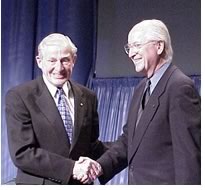

Graves Uses Strong Will,
Determination to
Continue Rehabilitation
Gold Medalist, paralyzed from the waist
down, makes steady progress

by Tracy F. Ostroff
Associate Editor
Michael Graves, FAIA, is “chipper” and “working away,” a spokeswoman says, as he continues intensive therapy at the Kessler Institute for Rehabilitation after a spinal infection left him paralyzed from the waist down.
His doctor, Steven Kirschbaum, associate medical director and director of spinal cord injury at the West Orange, N.J. hospital, says the permanence of the paralysis is unknown at this time. In a statement released by Graves’ office, Kirshbaum says, “Mr. Graves has made steady progress in his medical and physical condition while undergoing comprehensive rehabilitation at Kessler Institute. Mr. Graves’ strong will and determination to improve has been a major factor in his ability to enhance his upper body strength and functional activities.” In addition, his office noted that “he is fortunate to have full life expectancy and the ability to continue his professional activities as an architect and designer.”
 In the
short term, Graves’ office stated, the 2001 AIA Gold Medal winner
is “working on becoming self-sufficient living in a wheelchair,”
and that “nerve cells are slow-growing so the amount of regeneration
is not known at this time.”
In the
short term, Graves’ office stated, the 2001 AIA Gold Medal winner
is “working on becoming self-sufficient living in a wheelchair,”
and that “nerve cells are slow-growing so the amount of regeneration
is not known at this time.”
Meanwhile, Graves meets with members of his staff once or twice a day at Kessler to review projects, conduct media interviews, and other matters. “Since the day-to-day project design and management occurs through studios led by other principals of the firm, there has been little to no effect on our projects,” notes the Michael Graves & Associates statement. “In fact, we have been very busy and continue to get new work. The main impact has been Michael’s inability to travel during this period, which has limited his client contact. Our clients have been very understanding and supportive.” The firm reports that he will participate in some meetings via video or teleconferencing and will work on projects in the future directly at the office in the same way that he always has.
 Graves
and accessible design
Graves
and accessible design
Graves heads the 100-person Michael Graves & Associates, based in
Princeton, N.J., with an office in New York City. Among the firm’s
current projects are the U.S. Embassy in Seoul, South Korea, and ongoing
product designs for Target. Graves maintains his headquarters in two Colonial-era
houses across the street from each other. One is for Graves’ office
and the architecture and interiors practice, and the other for the product
design practice. Neither is accessible to wheelchairs. But, coincidentally,
says Caroline Hancock, director of communications at Michael Graves Associates,
because of the firm’s growth, they had already leased the first
floor of a small commercial building just down the block from the other
buildings. That building is accessible and will have an office for Graves
in the plans. Hancock said the building will be ready for occupancy later
this summer. Graves’ New York City office is in an elevator building
and is accessible.
For Graves’ home, Patrick Burke, AIA, an MGA principal, and his studio are “trying to find [the] least intrusive way to add an elevator to the exterior to fit the vernacular characteristics of the Graves’ home and connect it to existing corridors,” MGA notes. For example, in the bathroom they are looking at adding a wheel-in shower, selecting a different toilet, and lowering the mirrors.
As questions about the effect of Graves’ disability on his workspace and designs can best be answered in time, the AIA will continue to be in touch with Graves’ office to learn the architect’s thoughts on these design matters.
Copyright 2003 The American Institute of Architects.
All rights reserved. Home Page ![]()
![]()
 |
||
|
|
||